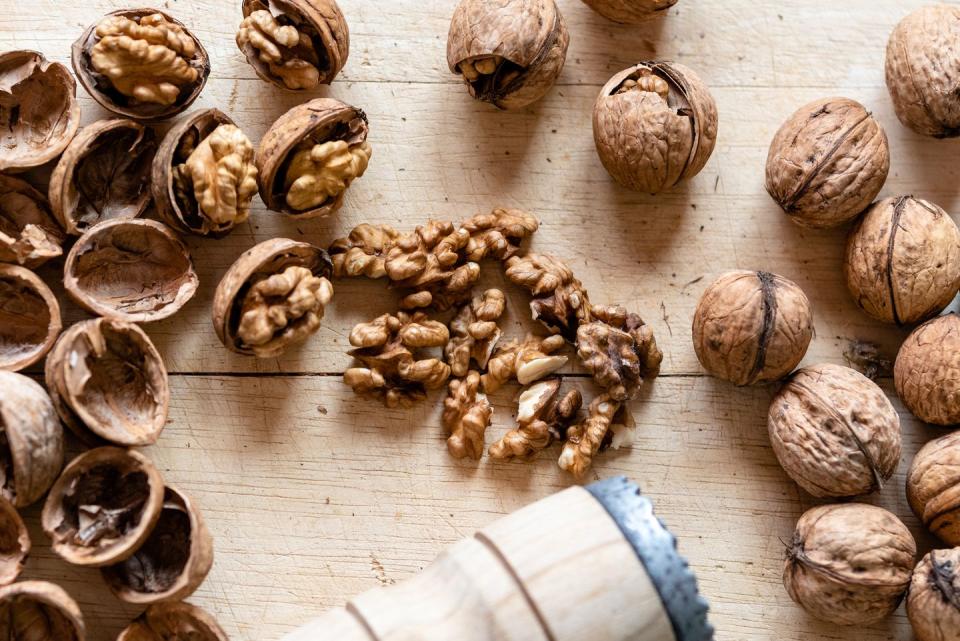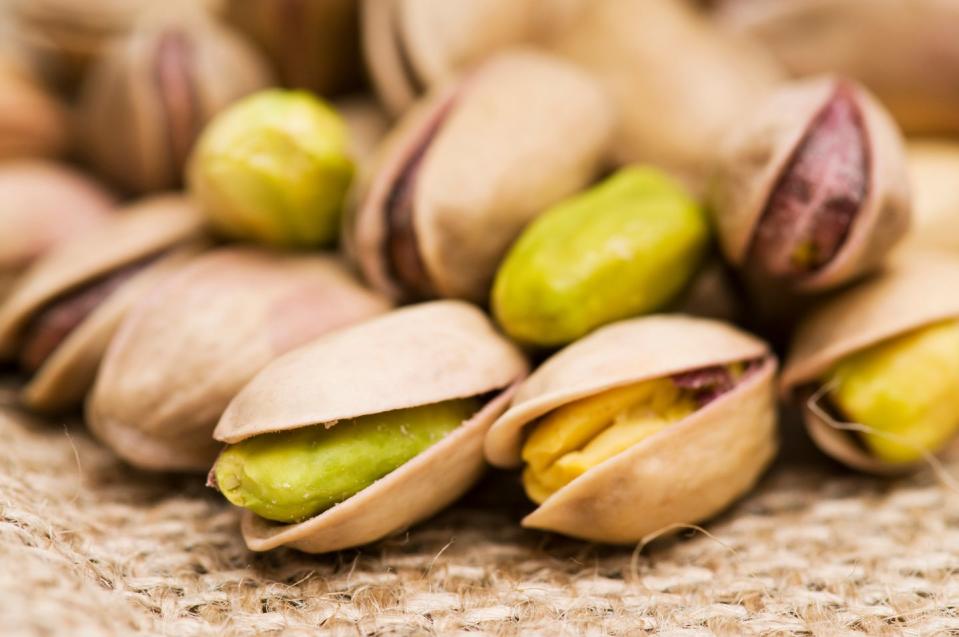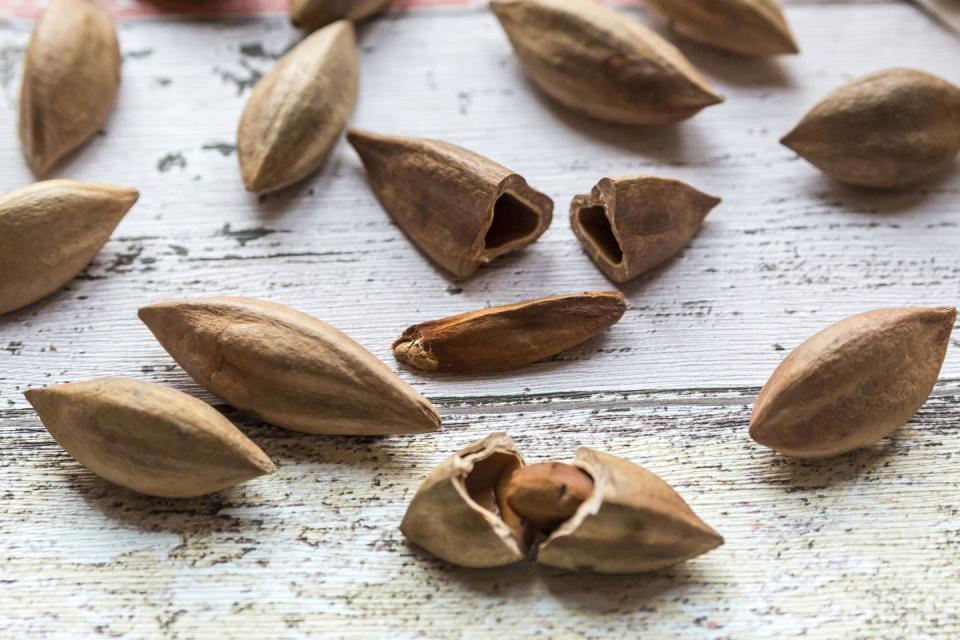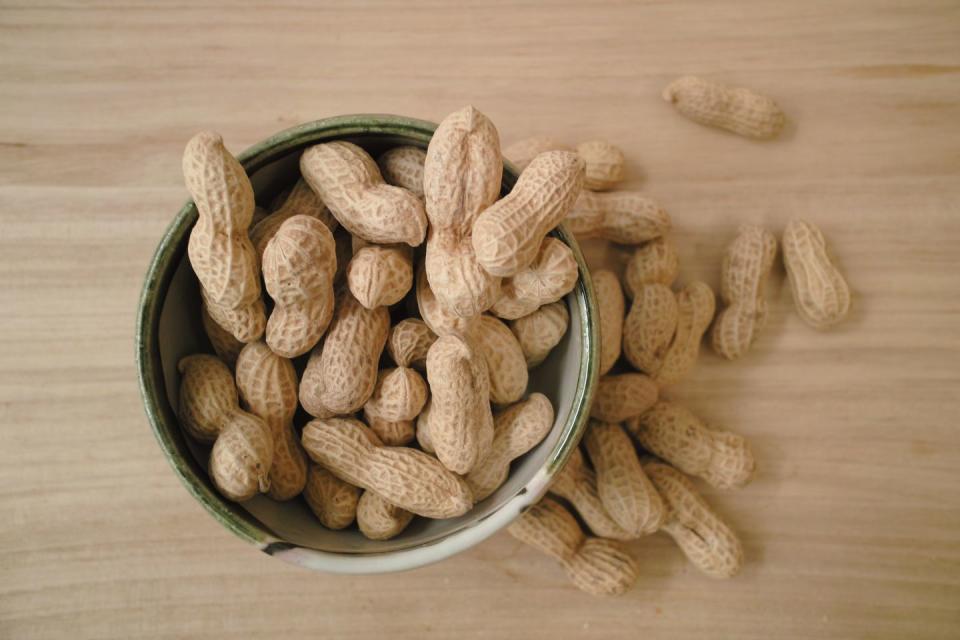6 Healthiest Nuts to Eat, According to Registered Dietitians

Small but mighty, nuts are one of the most nutritious foods on the planet and have been part of the human diet for centuries. While each individual nut has a distinct taste and slightly nutritional composition, all nuts are sources of plant-based protein, healthy fats and essential vitamins and minerals.
More and more research continues to show the nutritional benefits of incorporating nuts into your diet, from protecting against chronic diseases to promoting longevity. But are some nuts considered nutritionally superior to others? We consulted nutrition experts to share their top picks for the healthiest nuts to eat. When incorporating these nuts into your diet, aim for unsalted and unsweetened varieties when possible.
1. Walnuts

Nutrition Facts (1 oz, about 28 g or about 14 halves):
190 calories
18 g total fat
1.5 g saturated fat
4 g total carbohydrate
2 g dietary fiber
1 g total sugar
4 g protein
Walnuts are the only nut with an excellent source of plant omega-3 fatty acids says Wendy Bazilian, DrPH, RDN, Author of Eat Clean, Stay Lean and owner of Bazilian’s Health in San Diego. While some other nuts contain small amounts of omega-3s, Bazilian points out that none of them even approach the levels in walnuts.
Another important aspect of walnuts is their polyphenol content. "Based on research that evaluated tree nuts and peanuts, walnuts have the greatest amount of polyphenols, which are beneficial plant compounds that may play a role in a variety of diseases and health outcomes," Bazilian notes. Research findings show that when compared to control diets, walnut-enriched diets resulted in significantly greater decreases in total and LDL cholesterol and triglycerides.
Bazilian also shares that walnuts contain prebiotics, an indigestible fiber that fuels probiotics that has been shown to positively impact gut bacteria. She points out that walnuts contain melatonin as well, an important plant compound that plays a role in helping maintain healthy circadian rhythms and supporting quality sleep. And fascinating research from UCLA suggests that walnuts can play a role in male fertility.
Get creative: Try incorporating GH Nutritionist Approved California Walnuts into grain dishes like quinoa, wheat berries or couscous. Bazilian likes making pesto with half walnuts and half pine nuts, and she says that they also work great in stir-fries with snap peas and shrimp. Chopped walnuts can even be used as a plant-based alternative to ground beef or turkey since they have a similar look and feel.
2. Brazil Nuts

Nutrition Facts (1 oz, about 28 g or 6 kernels):
187 calories
19 g total fat
5 g saturated fat
3 g total carbohydrate
1 g total sugar
2 g dietary fiber
4 g protein
This nut that grows on trees in the Amazonian rain forest may not be as well-known as others on the list, but is a true nutritional powerhouse. With a smooth texture and delicate taste, this larger nut is an excellent source of various antioxidants and vitamins. Brazil nuts are a standout for their selenium content, a nutrient with many roles and antioxidant properties including protecting the body from oxidative damage and infection.
Just one Brazil nut contains anywhere from 68–91 mcg selenium per nut which meets over 100% of the recommended daily allowance for adults, and they contain 2,500 times as much selenium as any other nut. Research published in The American Journal of Clinical Nutrition even found that consuming just two Brazil nuts daily was an effective replacement for selenium supplements. But don't overdo it with this potent nut since eating too many Brazil nuts can lead to selenium toxicity; stick with 1 or 2 daily to reap the nutritional benefits.
Get creative: Enjoy Brazil nuts thrown into trail mix or add them chopped for a nice crunch in salads. Since they have a similar taste and feel to macadamia nuts, they can also be chopped and used in baked goods.
3. Pistachios

Nutrition Facts (1oz, about 28 g or 49 kernels):
160 calories
13 g total fat
2 g saturated fat
8 g total carbohydrate
2 g dietary fiber
2 g total sugars
6 g protein
"Pistachios are one of the highest protein snack nuts," says Maggie Moon, MS, RD, Associate Vice President of Nutrition Communications for Wonderful Pistachios. "They offer six grams of plant protein per serving that help fuel your body with essential amino acids." Plus, they pack in three grams of fiber per serving and about 90% of the fats found in pistachios are the better-for-you mono- and polyunsaturated types she says.
Moon also points out that pistachios give you more nuts per serving (about 49 pistachios, compared to 23 almonds or 18 cashews). No shell pistachios are a kitchen staple and easy to add to any meal or snack, but in-shell pistachios may encourage you to slow down and eat more mindfully. "The leftover shells can be a visual cue for portions, potentially helping to curb intake," Moon shares.
Get creative: Moon loves adding GH Nutritionist Approved Wonderful Pistachios to pastas for crunch, protein and fiber. She also recommends adding pistachios on tomato soup or chili and even says they blend well in smoothies since they are a softer nut.
4. Almonds

Nutrition Facts (1oz, about 28g or 23 kernels):
165 calories
14 g total fat
1 g saturated fat
6 g total carbohydrate
4 g dietary fiber
1 g total sugar
6 g protein
A snacking staple, almonds are also packed with plant-based protein but are a standout due to their excellent vitamin E content. "Vitamin E promotes healthy skin, nails and hair and is a powerful antioxidant that helps fight inflammation," says Bonnie Taub-Dix, RDN, creator of BetterThanDieting.com, author of Read It Before You Eat It: Taking You from Label to Table. She adds that recent studies have shown almonds play a role in prevention of wrinkles. "As a rich source of vitamin E, essential fatty acids and polyphenols, healthy aging can be addressed easily and deliciously by including almonds as a staple in your diet," says Taub-Dix.
But their nutritional benefits don't just stop there. "Almonds are the lowest in saturated fat and highest in riboflavin, niacin, fiber and calcium," Taub-Dix shares. "They have also been shown to reduce harmful cholesterol levels (LDL cholesterol) and help stabilize blood sugar levels to help control diabetes."
Get creative: Try sliced almonds in your breakfast omelet or tossed on your lunchtime salad. An almond crust on chicken or fish for dinner is exceptionally delicious and packs in a great crunch Taub-Dix adds. Her favorite are Blue Diamond Flavored Almonds, like Habanero BBQ and Honey Roasted, which add in delicious bold flavor.
5. Pili Nuts

Nutrition Facts (30g):
210 calories
24 g total fat
9 g saturated fat
1 g total carbohydrate
1 g dietary fiber
0 g total sugar
3 g protein
This creamy, buttery nut is grown in the volcanic soil of the Philippine peninsula. They are among the highest nut sources of magnesium, an important mineral for regulating muscle and nerve function, energy production, blood pressure control and bone health; a 30 g serving provides 89 mg magnesium or 20% of the daily value, making it an excellent source of the nutrient. Pili nuts are also packed with essential amino acids and heart-healthy monounsaturated fats. Compared to other nuts, this variety is the lowest in carbohydrates as well. They also contain 35% of the daily value for copper and 30% of the daily value for manganese.
Get creative: Try pili nuts sprinkled on your morning oatmeal or smoothie bowl. They work great in yogurt parfaits and in chia pudding too for nice texture.
6. Peanuts

Nutrition Facts (1 oz, about 28g)
161 calories
14 g total fat
2 g saturated fat
5 g total carbohydrate
2 g dietary fiber
1 g total sugar
7 g protein
Although not technically a nut (peanuts belong to the legume family), this snacking staple has a similar nutrient profile to other nuts and packs in some great health benefits. Peanuts are an excellent source of niacin, an important B vitamin that helps to convert food to energy, as well as manganese which is important for processing cholesterol. But some of biggest peanut benefits are environmental; since they grow in the ground, peanuts use substantially less water than tree nuts to grow. Plus, they naturally replenish and enrich the soil with nitrogen. Options like GH Nutritionist Approved Hampton Farms Unsalted Fancy In-Shell Peanuts allow you to crack each shell open which is a fun stress reliever that may also allow you to slow down and eat more mindfully.
Get creative: Peanuts pair great in stir-fry dishes and are an excellent addition to homemade granola. Peanut butter can be used for peanut sauce on noodles or as a dipping sauce for satay.
You Might Also Like

 Yahoo Movies
Yahoo Movies 
